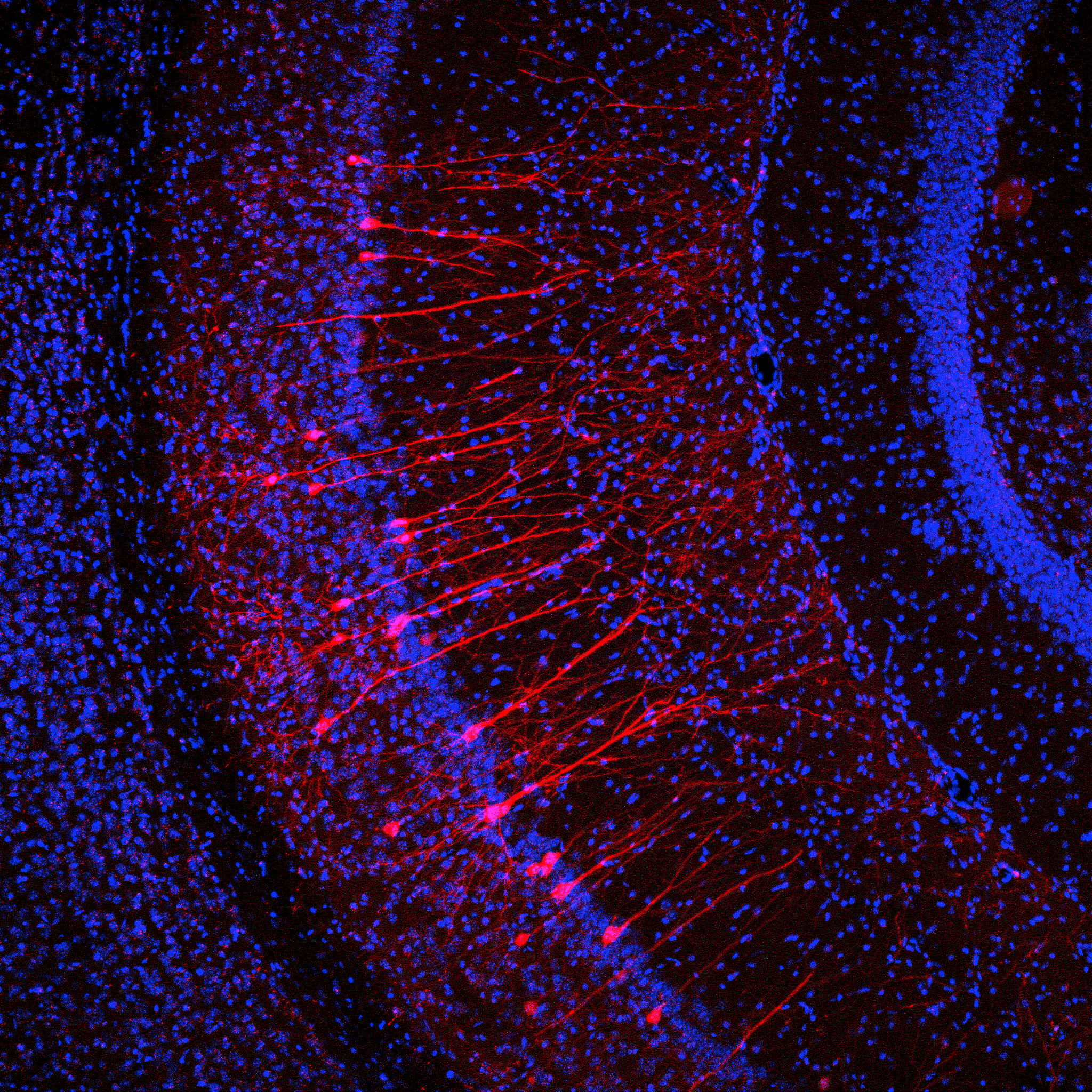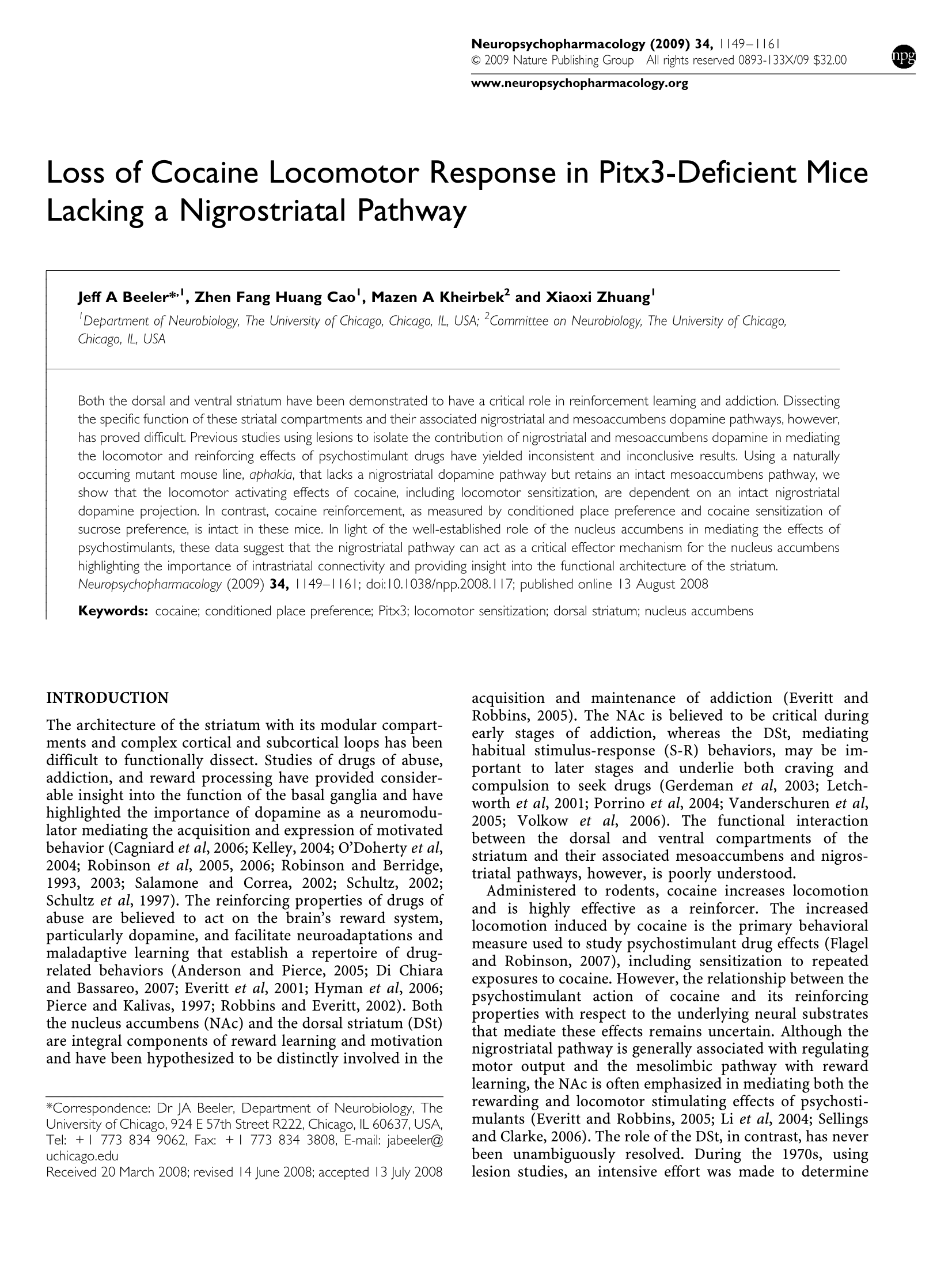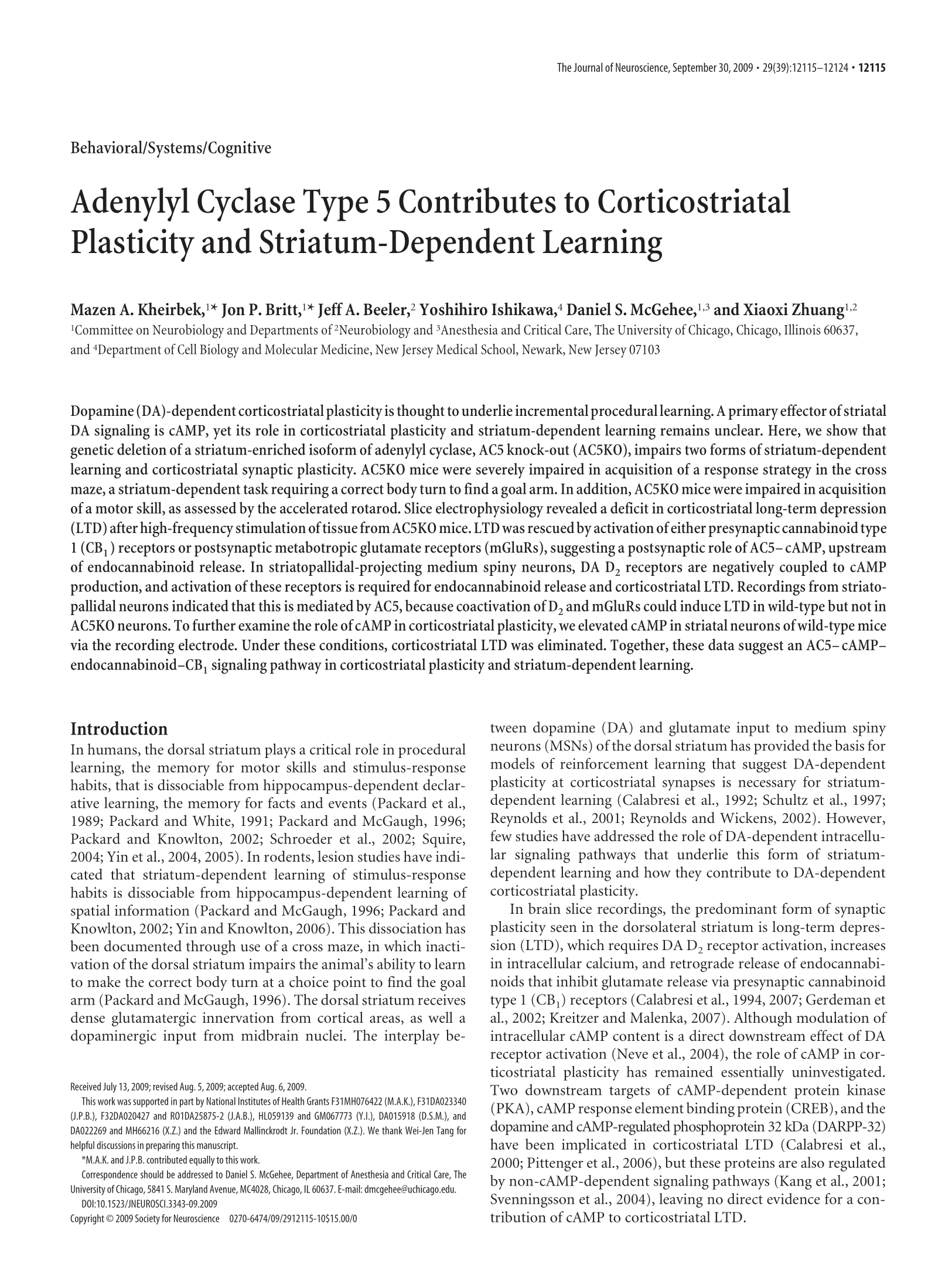
Publications

Dissociation of reinforcement and locomotor effects of cocaine in Pitx3 deficient mice
Beeler JA, Cao ZFH, Kheirbek MA, Zhuang X (2009)
Neuropsychopharmacology
Both the dorsal and ventral striatum have been demonstrated to have a critical role in reinforcement learning and addiction. Dissecting the specific function of these striatal compartments and their associated nigrostriatal and mesoaccumbens dopamine pathways, however, has proved difficult. Previous studies using lesions to isolate the contribution of nigrostriatal and mesoaccumbens dopamine in mediating the locomotor and reinforcing effects of psychostimulant drugs have yielded inconsistent and inconclusive results. Using a naturally occurring mutant mouse line, aphakia, that lacks a nigrostriatal dopamine pathway but retains an intact mesoaccumbens pathway, we show that the locomotor activating effects of cocaine, including locomotor sensitization, are dependent on an intact nigrostriatal dopamine projection. In contrast, cocaine reinforcement, as measured by conditioned place preference and cocaine sensitization of sucrose preference, is intact in these mice. In light of the well-established role of the nucleus accumbens in mediating the effects of psychostimulants, these data suggest that the nigrostriatal pathway can act as a critical effector mechanism for the nucleus accumbens highlighting the importance of intrastriatal connectivity and providing insight into the functional architecture of the striatum.

Adenylyl cyclase type V contributes to corticostriatal plasticity and striatum dependent motor learning
Kheirbek MA, Britt JP, Beeler JA, Ishikawa Y, McGehee DS, Zhuang X (2009)
Journal of Neuroscience
Dopamine (DA)-dependent corticostriatal plasticity isthoughtto underlie incremental procedural learning. A primary effector of striatal DA signaling is cAMP, yet its role in corticostriatal plasticity and striatum-dependent learning remains unclear. Here, we show that genetic deletion of a striatum-enriched isoform of adenylyl cyclase, AC5 knock-out (AC5KO), impairs two forms of striatum-dependent learning and corticostriatal synaptic plasticity. AC5KO mice were severely impaired in acquisition of a response strategy in the cross maze, a striatum-dependent task requiring a correct body turn to find a goal arm. In addition, AC5KO mice were impaired in acquisition of a motor skill, as assessed by the accelerated rotarod. Slice electrophysiology revealed a deficit in corticostriatal long-term depression (LTD) after high-frequency stimulation oftissuefrom AC5KOmice. LTD was rescued by activation of either presynaptic cannabinoidtype 1 (CB1 ) receptors or postsynaptic metabotropic glutamate receptors (mGluRs), suggesting a postsynaptic role of AC5– cAMP, upstream of endocannabinoid release. In striatopallidal-projecting medium spiny neurons, DA D2 receptors are negatively coupled to cAMP production, and activation of these receptors is required for endocannabinoid release and corticostriatal LTD. Recordings from striato pallidal neurons indicated that this is mediated by AC5, because coactivation of D2 and mGluRs could induce LTD in wild-type but not in AC5KO neurons. To further examine the role of cAMP in corticostriatal plasticity, we elevated cAMP in striatal neurons of wild-type mice via the recording electrode. Under these conditions, corticostriatal LTD was eliminated. Together, these data suggest an AC5– cAMP– endocannabinoid–CB1 signaling pathway in corticostriatal plasticity and striatum-dependent learning.

A cAMP Pathway Underlying Reward Prediction in Associative Learning
Kheirbek MA, Beeler JA, Ishikawa Y, Zhuang X (2008)
Journal of Neuroscience
In associative learning, animals learn to associate external cues or their own actions with appetitive or aversive outcomes. Although the dopamine (DA) system and the striatum/nucleus accumbens have been implicated in both the pavlovian and instrumental form of associative learning, whether specific neuronal signaling mechanisms underlie oneform orthe other is unknown.Here, we reportthatthe striatum-enriched isoform of adenylyl cyclase (AC), AC5, is selectively required for appetitive pavlovian learning. Mice with genetic deletion of AC5 (AC5KO) acquired instrumental responding yet were unable to use cues that predicted reward delivery. The specificity of this deficit was confirmed by an inability of AC5KO mice to learn a simple appetitive pavlovian conditioning task. Conversely, AC5KO mice showed intact aversive pavlovian learning, suggesting the deficit was specific for learning about appetitive outcomes. Our results suggest that AC5 is a critical component of DA-dependent strengthening of stimulus–reward contingencies.

A molecular switch for induction of long-term depression of corticostriatal transmission
Kheirbek MA (2007)
Journal of Neuroscience

Hox gene misexpression and cell-specific lesions reveal functionality of homeotically transformed neurons
Hale ME, Kheirbek MA, Schriefer JE, Prince VE (2004)
Journal of Neuroscience
Hox genes are critical for establishing the segmental pattern of the vertebrate hindbrain. Changes in their expression can alter neural organization of hindbrain segments and may be a mechanism for brain evolution. To test the hypothesis that neurons induced through changes inHox gene expression can integrate into functional neural circuits, we examined the roles of ectopic Mauthner cells (M-cells) in the escape response of larval zebrafish. The activity of the paired Mauthner cells in rhombomere 4 (r4) has been shown to be critical for generating a high-performance startle behavior in response to stimulation of the tail (Liu and Fetcho, 1999). Previous studies have found that misexpression of particular Hox genes causes ectopic M-cells to be generated in r2 in addition to the r4 cells (Alexandre et al., 1996; McClintock et al., 2001). With calcium imaging, we found that the homeotically transformed neurons respond to startle stimuli. To determine the roles of ectopic and endogenous M-cells in the behavior, we lesioned the r2, r4, or both M-cells with cell-specific laser lesion and examined the effect on startle performance. Lesion of the normal M-cells did not decrease escape performance when the ectopic cells were present. These results indicate that the homeotically transformed Mauthner cells are fully functional in the escape circuit and are functionally redundant with normal M-cells. We suggest that such functional redundancy between neurons may provide a substrate for evolution of neural circuits.

Knockdown of duplicated zebrafish hoxb1 genes reveals distinct roles in hindbrain patterning and a novel mechanism of duplicate gene retention
McClintock JM, Kheirbek MA, Prince VE (2002)
Development
We have used a morpholino-based knockdown approach to investigate the functions of a pair of zebrafish Hox gene duplicates, hoxb1a and hoxb1b, which are expressed during development of the hindbrain. We find that the zebrafish hoxb1 duplicates have equivalent functions to mouse Hoxb1 and its paralogue Hoxa1. Thus, we have revealed a ‘function shuffling’ among genes of paralogue group 1 during the evolution of vertebrates. Like mouse Hoxb1, zebrafish hoxb1a is required for migration of the VIIth cranial nerve branchiomotor neurons from their point of origin in hindbrain rhombomere 4 towards the posterior. By contrast, zebrafish hoxb1b, like mouse Hoxa1, is required for proper segmental organization of rhombomere 4 and the posterior hindbrain. Double knockdown experiments demonstrate that the zebrafish hoxb1 duplicates have partially redundant functions. However, using an RNA rescue approach, we reveal that these duplicated genes do not have interchangeable biochemical functions: only hoxb1a can properly pattern the VIIth cranial nerve. Despite this difference in protein function, we provide evidence that the hoxb1 duplicate genes were initially maintained in the genome because of complementary degenerative mutations in defined cis-regulatory elements.
